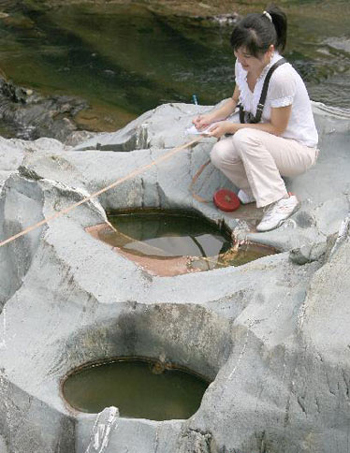On Sept. 13, 2008, numerous strange holes were discovered on a 3-kilometer stretch of exposed riverbed in Liguang Mountain at Wangcun Town, Huangshan City, in southeast China's Anhui Province. The holes, of various shapes and depths, look like traditional Chinese wet rice grinding mortars. Experts forecast that the holes will turn out to be ancient ice mortars, uncommon in the south of China. If this is the case, the holes could have been formed between 120,000 and 700,000 years ago.
At a preliminary estimate, there are about ten thousands holes resembling stone mortars on the 3-kilometer riverbed stretch. In addition to these "stone mortars", other ice relics such as glacial boulders, boulder ice mortars and ice columns were discovered. Although a quarter of the ice mortars are still covered with soil and weeds, they will be subject to local government protection. Exactly how the holes were formed is still a riddle and requires further research.
Ice mortars - background info:
Ice mortars are a result of glaciation and glacial environments. When glacial melt waters erode a glacier's crevasses, carrying with them ice scraps and small stones, over a long period of time this will cause significant erosion to bedrock. In due course a hole called an ice mortar is formed. The name comes from the shape, which resembles an ancient stone grain-grinding mortar.
(China.org.cn September 16, 2008)
| Tools: Save | Print | E-mail | Most Read |
| Comment |
On Sept. 13, 2008, numerous strange holes were discovered on a 3-kilometer stretch of exposed riverbed in Liguang Mountain at Wangcun Town, Huangshan City, in southeast China's Anhui Province. The holes, of various shapes and depths, look like traditional Chinese wet rice grinding mortars. Experts forecast that the holes will turn out to be ancient ice mortars, uncommon in the south of China. If this is the case, the holes could have been formed between 120,000 and 700,000 years ago.
